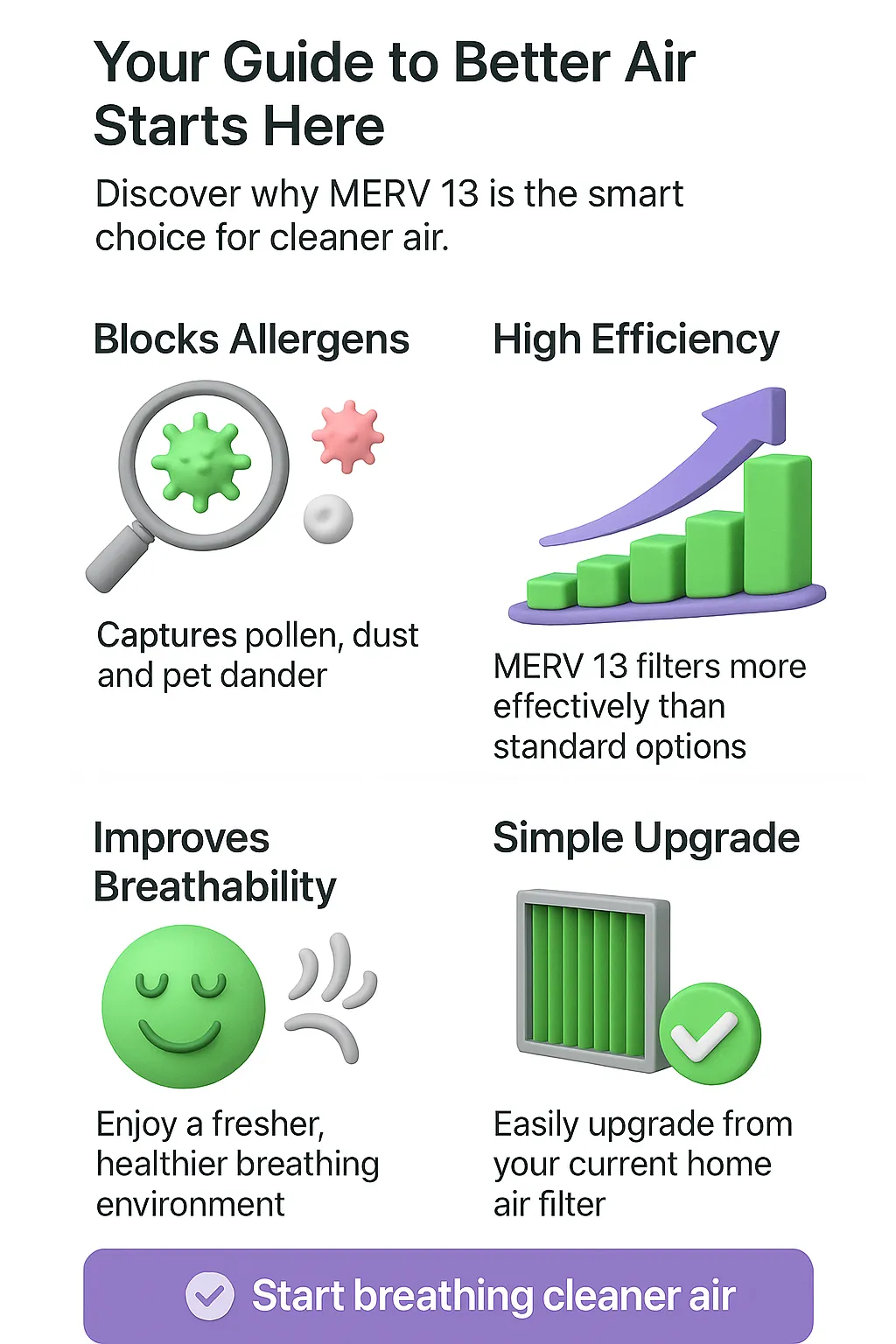Are you constantly battling indoor allergies or waking up with a stuffy nose? The air inside your home might be to blame. Fortunately, there’s a simple yet powerful solution by upgrading to a MERV 13 HVAC and furnace air conditioning filter for home. This guide unpacks why this high-efficiency filter is one of the smartest decisions you can make for your air quality—and your health.
Top Takeaways
- MERV 13 filters trap 90%+ of airborne particles, including allergens and bacteria.
- They reduce allergy symptoms and improve indoor comfort quickly.
- The upgrade helps protect your HVAC system and enhances efficiency.
- Easy to install and maintain for long-term health benefits.
Why MERV 13 Filters Are a Game-Changer for Home Air Quality
Standard filters rated below MERV 13 do little more than trap visible dust. In contrast, MERV 13 filters capture over 90% of particles between 1–3 microns—including pollen, mold spores, pet dander, bacteria, and more. The difference is immediate and noticeable.
- Breathing becomes easier.
- Sneezing and congestion reduce significantly.
- Surfaces stay cleaner with less dust buildup.
This is more than just theory. Countless homeowners—including our team—have experienced clearer air and better sleep within days of switching to a MERV 13 filter.
What Makes MERV 13 Stand Out?
- Exceptional filtration: Targets allergens invisible to the eye.
- Healthier indoor environment: Traps bacteria, mold spores, and viruses.
- HVAC protection: Reduces debris buildup and supports system efficiency.

Real-World Story: What Happened After a Filter Upgrade
A family in Houston, Texas dealt with constant allergy flare-ups, especially in their 6-year-old daughter. After switching to a MERV 13 filter:
Her nighttime coughing disappeared.
Dust buildup was cut in half.
Air quality monitor showed a 35% drop in PM2.5 particles.
Sleep quality improved for everyone in the home.
This simple upgrade brought comfort and health benefits that no over-the-counter allergy product had matched.
Supporting Statistics That Matter
EPA: Recommends MERV 13 filters to reduce particles and viruses indoors source.
CDC & ASHRAE: Support MERV 13 or higher for clean air in homes and public buildings source.
DesignFilters.com: Reports that MERV 13 filters trap more than 90% of particles in the 1–3 micron range, including allergens and respiratory irritants.
Final Thought: A Small Filter With Big Impact
Don’t underestimate the value of the right air filter. Cheap, thin filters often recirculate harmful particles. MERV 13 filters, on the other hand, offer real, measurable improvements. They bring relief to allergy sufferers, promote cleaner living environments, and extend the life of your HVAC system—all at an affordable price.
If your HVAC system can accommodate a MERV 13 filter, it’s one of the easiest health upgrades you can make.
Next Steps: Upgrade With Confidence
Check system compatibility: Consult your HVAC manual or technician.
Measure filter size: Standard sizes like 16x20x1 or 20x25x4 are common.
Choose high-quality MERV 13 filters: Look for pleated, residential-grade options.
Install properly: Follow airflow arrows and ensure a tight fit.
Set reminders: Change the filter every 2–3 months for best performance.
Consider air quality monitoring: Use a PM2.5 monitor to track your progress.
Frequently Asked Questions
What makes a MERV 13 filter better than lower-rated filters?
MERV 13 filters capture over 90% of particles between 1–3 microns, including pollen, mold, pet dander, smoke, and bacteria. Lower-rated filters (like MERV 8) only capture larger debris like dust and lint.
Can my home HVAC system handle a MERV 13 filter?
Most residential HVAC systems built in the last 10–15 years can handle MERV 13 filters. However, it’s best to check your system's manual or consult an HVAC technician to confirm airflow compatibility.
How often should I replace a MERV 13 air filter?
Replace every 2–3 months under normal conditions. If you have pets, allergies, or live in a high-pollution area, consider replacing it monthly for optimal air quality.
Do MERV 13 filters help with allergies and asthma?
Yes. They’re highly effective at trapping allergens like pet dander, pollen, and mold spores—common triggers for asthma and allergies—making indoor air safer and easier to breathe.
Are MERV 13 filters energy efficient?
When properly matched to your HVAC system, MERV 13 filters can help maintain airflow while reducing dust on system components. This helps your system run efficiently and extends its lifespan.
To truly elevate your home’s air quality, it’s not just about the filter—it’s about the entire HVAC ecosystem working together. That’s where complementary upgrades like the precision-focused benefits of Aeroseal HVAC Air Duct Sealing come into play, helping to prevent air leaks that undermine your MERV 13 HVAC and furnace air conditioning filter for home. Similarly, routine system upkeep as outlined on West Palm Beach FL HVAC Repair ensures the filter operates at peak efficiency. And while improving home air often feels like a behind-the-scenes effort, it shares a similar intent with broader wellness decisions—such as those explored in The Pros and Cons of Private School Ownership and Why Are You Considering a Private School for Your Child, both of which highlight how investing in better environments pays dividends for long-term quality of life.






